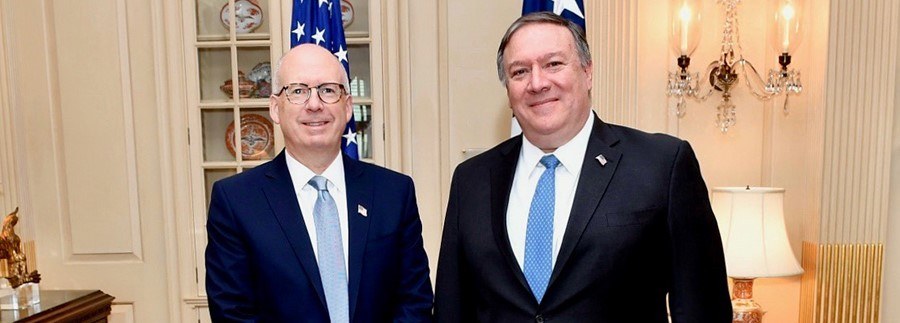
State names first permanent CIO in 15 months
State Department Secretary Mike Pompeo named Stuart McGuigan as the agency’s new CIO and head of the Bureau of Information Resource Management.
The State Department has its first permanent chief information officer in more than 15 months and is expected to name a new principal deputy CIO in the coming days.
State Department Secretary Mike Pompeo named Stuart McGuigan as the agency’s new CIO and head of the Bureau of Information Resource Management.
Sources say Michael Mestrovich will join State as the principal deputy CIO, coming over from the CIA as its technical director of the Technical Services Office.
“Stuart’s extraordinary professional background gives me confidence he will adapt our IT structures to operate with maximum effectiveness,” Pompeo wrote in an email to staff, which Federal News Network obtained.

A spokesman for the State Department confirmed McGuigan’s appointment, but said he didn’t have any other official announcements about a new deputy CIO.
McGuigan replaces Karen Mummaw, who is retiring in April after 31 years at State. He also will be the first permanent CIO since Frontis Wiggins retired in December 2017.
“I also want to express my personal thanks to Karen Mummaw for her service these past 15 months as State’s acting CIO. Karen is a career Senior Foreign Service Officer, class of Minister Counselor, with a distinguished record of service at home and abroad,” Pompeo wrote. “Her sacrificial service exemplifies what our team is all about.”
Mestrovich, who is expected to start at State on April 1, has been with the CIA for the last five years and before that worked at the Defense Intelligence Agency in various technology implementation roles, including as the chief architect, who developed the architecture, design and engineering of the intelligence community’s unified desktop computing system for 150,000 personnel, from 2008 to 2014.
McGuigan comes to State from the private sector where he was CIO of Johnson & Johnson for the past nearly seven years. As CIO, he oversaw the IT strategy and operations for the company’s 130,000 employees around the world, and worked with senior leadership on business improvement programs and to drive more overall technology effectiveness.
Prior to Johnson & Johnson, McGuigan was CIO and senior vice president for CVS Caremark, and served as senior vice president and CIO for Liberty Mutual Insurance Group.
“Every aspect of the Department’s information technology capabilities and operations now falls under Stuart’s oversight, including architecture, infrastructure, cybersecurity, data management, software, and application development and acquisition,” Pompeo writes. “This unity of command is a vital step for ensuring our lines of effort are properly coordinated and deliver the best results.”
Pompeo is referring to language in the fiscal 2019 omnibus appropriations bill that reiterated and reinforced the CIO’s authorities.
Lawmakers wrote: “None of the funds appropriated in title I of this act under the heading ‘Administration of Foreign Affairs’ may be made available for a new major information technology investment without the concurrence of the CIO, Department of State. (B) In complying with the requirements of this paragraph, the CIO, Department of State, shall consider whether a new major information technology investment- (i) is consistent with the department Information Technology Strategic Plan; (ii) maintains consolidated control over enterprise IT functions or improves operational maintenance; (iii) improves Department of State resiliency to a cyber-attack; (iv) reduces department of State IT costs over the long-term; and (v) is in accordance with the Federal 6 Acquisition Regulation (FAR), including FAR Part 6 regarding competition requirements.”
It’s well known in the federal IT community that the State CIO has struggled for decades to oversee IT investments by the Foreign Service.
McGuigan steps into his new role at a time of major transformation for the agency.
During her tenure, Mummaw helped lead State’s continued move to the cloud. State has two main goals as part of its modernization plan: the centralization of back-office or commodity IT and consuming IT-as-a-service.
State still faces several challenges with its $2.2 billion IT budget, of which the CIO’s office controls only about $725 million. The federal IT dashboard says 84 percent of State’s projects are on schedule, but only 52 percent are on budget. Additionally, State continues to recover from a recent breach of its unclassified email system.
Copyright © 2025 Federal News Network. All rights reserved. This website is not intended for users located within the European Economic Area.
Jason Miller is executive editor of Federal News Network and directs news coverage on the people, policy and programs of the federal government.
Follow @jmillerWFED
Related Stories

State Dept.’s move to hybrid cloud underpinning new IT modernization strategy





